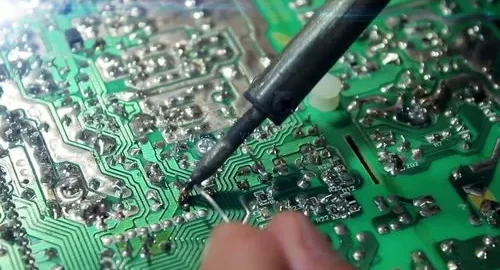Breaking down the barriers to welding
This article describes that technological breakthroughs in chemistry and particle morphology have led to the development of new welding alternative materials. As the electronics manufacturing industry enters a new century, the industry is pursuing a more environmentally friendly manufacturing environment. Since the implementation of the Montreal Treaty in 1987 (an international treaty for the protection of the ozone layer from various substances, including atmospheric particles, refrigeration products and solvents), there has been great concern for the environment and the industries and activities that affect it. Today, this concern has expanded to include a global interest in eliminating lead from electronics manufacturing.
Since the birth of printed circuit boards, lead-tin bonding has been the primary method of connection in the electronics industry. Now, laws are being implemented in Japan, Europe, and North America to reduce the use of lead in manufacturing. This movement, along with the push toward greater miniaturization with increased functionality in the electronics and semiconductor industries, has caused manufacturers to look for alternatives to traditional soldering processes. The New Industrial Revolution This is an interesting time of changing technology and industrial practices.
For more than fifty years, soldering has proven to be a reliable and effective electronic joining process. However, the challenge is to develop new materials that have the same properties as solder, such as temperature and electrical properties, as well as mechanical solder joint strength, while at the same time pursuing the elimination of undesirable factors, such as solvent cleaning and solvent gas efflux. Over the past two decades, adhesive manufacturers have made progress in breaking down barriers to welding that I think are worth considering in today’s market. It’s All About Chemistry Technological breakthroughs in chemistry and particle morphology have led to the development of new welding alternative materials.
Over the past two decades, adhesive manufacturers have developed electrically conductive adhesives (ECA) that are lead-free, do not require halogenated solvents for cleaning, and are electrically conductive. These glues also cure at temperatures below 150°C (compare the 220°C required for solder reflow soldering), which makes conductive adhesives understandable for fixing temperature-sensitive components such as semiconductor chips, and can also be used on low-temperature substrates and Housing (e.g. plastic). These properties and manufacturing usage have led to their acceptance in specialized areas of primary connectivity, including hybrid microelectronics, hermetic packaging, sensor technology as well as baredie, flexible circuits direct-chip attachment.
Hybrid microelectronics, hermetic packaging and sensor technology: Epoxies are widely used in hybrid microelectronics and hermetic packaging, mainly because these systems have a box-shaped package that surrounds the electronic circuitry. This packaging protects the electronic circuit and prevents damage to components and bonding materials. Solder is also traditionally used in secondary connections, where damage due to handling is an issue, but since the entire electronic package is hermetically sealed, soldering may not be necessary. Hybrid microelectronics packages are mostly used in military electronics, but are also widely used in the automotive industry for engine control and timing mechanisms (under the hood) and for some under-dash applications such as dual-gas control and air bag detonation. device. Sensor technology also uses conductive glue to encapsulate pressure transducers, motion, light, sound and vibration sensors. Conductive adhesives have proven to be a reliable and effective method of joining in these applications.
Flexible circuits: Flexible circuits are another application area where conductive adhesives are used. The substrate material of flexible circuits, such as polyester film (Mylar), requires low-temperature processing. Due to the low temperature requirements, conductive glue is ideal. Flexible circuits are used in consumer electronics such as cell phones, computers, keyboards, hard drives, smart cards, office printers and are also used in medical electronics such as hearing aids. Adhesive manufacturers are making progress in breaking down the welding barriers due to space and packaging constraints. Consider, lower temperature processing and reduced use of solvents and lead. As space becomes more and more at a premium when designing PCBs and electronic devices, the use of bare chips rather than packaged components is becoming more common. Packaged components often have pre-tinned connections, so they replace connection methods. The epoxy cure temperature does not negatively affect the chip, and the connection also eliminates the presence of lead.
In cases where product designs can benefit from overall size reduction (e.g., hearing aids) eliminating solder joints from surface mount technology packages and replacing them with epoxy will help reduce overall size. Understandably, by reducing size, manufacturers can often achieve competitive profit margins due to increased market share. In developing electronic components from the outset, packaging and design engineers can take advantage of lower-cost plastic components and substrates because conductive adhesives can be used for connections.
Another trend emerging from the elimination of lead is the increased use of precious metals as component electrodes, such as gold, silver and palladium, with epoxy resins replacing these metals as joining materials. In addition, PCBs and electronic components manufactured with epoxy resin do not require solvent flushing or solvent treatment, thus giving significant cost savings. The future is bright. Conductive adhesives have taken important steps in penetrating the solder market. As the electronics industry continues to grow and develop, I believe that electrically conductive adhesives (ECA0) will play an important role in circuit connections and will become even more dominant as an incentive to eliminate lead. And with the use of miniaturized and xystem-on-chip designs in electronics manufacturing, further research into the use of epoxies as primary and secondary connections will be conducted.
Send us an inquiry , we will get back to you soon ,thank you!
[wpforms id=”20484″]

